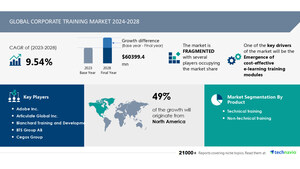NEW YORK, March 8, 2024 /PRNewswire/ -- The global biopesticides market size is estimated to grow by USD 5.66 billion from 2022 to 2027. The market is estimated to grow at a CAGR of 16.27% during the forecast period. The demand for organic products is a significant driving factor for the growth of the market. Organic pesticides are obtained from natural sources. Natural sources include animals, bacteria, minerals, and plants, whereas synthetic pesticides, on the other hand, are made artificially and contain various chemicals and harmful products. Furthermore, human consumption of inorganic food products also contributes to the degradation of the environment. Organic food is produced using reusable resources, which limit the usage of harmful pesticides and chemicals in food products and is usually observed that organic farming is practiced in small, family-run farms, where the utmost importance is dedicated to the quality of soil and water, ensuring fertile lands even for future generations. Hence, such factors fuel the market growth during the forecast period.
For more insights on the historic (2017 to 2021) and forecast market size (2023 to 2027) - Request a sample report
Report Coverage |
Details |
Page number |
180 |
Base year |
2022 |
Historic period |
2017 - 2021 |
Forecast period |
2023-2027 |
Growth momentum & CAGR |
Accelerate at a CAGR of 16.27% |
Market growth 2023-2027 |
USD 5.66 billion |
Market structure |
Fragmented |
YoY growth 2022-2023(%) |
13.98 |
Regional analysis |
North America, Europe, APAC, South America, and Middle East and Africa |
Performing market contribution |
North America at 30% |
Key countries |
US, China, India, Germany, and UK |
Segment Overview
This report extensively covers market segmentation by type (bioherbicides, bio fungicides, bioinsecticides, bionematicides, and others), product (natural products, microbial, microbial, and semiochemicals), and geography (North America, Europe, APAC, South America, and Middle East and Africa).
- The market share growth by the bioherbicide segment will be significant for overall market growth during the forecast period. It is a type of pesticide that is widely used to kill and inhibit the growth of unwanted plants. Some of the main microbial agents used as pathogens in bioherbicides include bacteria, fungi, and viruses. Furthermore, another major driver is the growing focus on the cultivation of eco-friendly weed killers. Additionally, reduced chemical hazards, ease of residue management, and better quality and nutritional value of crops that are treated with bioherbicides are expected to contribute significantly to the growth of this market segment. Hence, such factors drive the segment growth during the forecast period.
Geography Overview
By geography, the global biopesticides market is segmented into North America, Europe, APAC, South America, and Middle East and Africa. The report provides actionable insights and estimates the contribution of all regions to the growth of the global biopesticides market.
- North America is estimated to account for 30% of the growth of the global market during the forecast period. Factors such as the simple registration processes for biopesticides, growing consumer preference for organic products, and rising awareness of the ill effects of synthetic pesticides on human health drive regional market growth. Furthermore, in 2020, the US and Canada constituted the largest biopesticides market in North America. Hence, such factors are expected to drive the regional market growth during the forecast period.
Insights on the market contribution of various segments including country and region wise, historic (2017 to 2021) and forecast market size (2023 to 2027) - Download a Sample Report
Advances in biopesticide development are an emerging trend influencing market growth.
To reconstruct the evolution of natural microbial enemies and disrupt the molecular basis for their pathogenicity, molecular-based technologies are used in research. This is carried out in order to understand how weeds fight with crops and develop resistance to herbicides and to identify the characteristics of the receptor proteins present in insects for detecting semi-chemicals. Hence, such trends boost the market growth during the forecast period.
- Lack of awareness of the usage of biopesticides is a key challenge hindering market growth.
Insights on Market Drivers, trends, & Challenges, historic period(2017 to 2021) and forecast period(2023 to 2027) - Request a sample report!
Analyst Review
In the modern agriculture, the demand for organic solutions has surged, driven by environmental concerns and the pursuit of healthier food options. This shift has propelled the Organic Trade Association and organizations like the Research Institute of Organic Agriculture (FiBL) into the spotlight, advocating for sustainable farming practices worldwide. As conventional pesticide use comes under scrutiny for its adverse effects on ecosystems and human health, biopesticides have emerged as a promising alternative, championed by both governmental bodies like the United States Department of Agriculture and international agencies such as the Agricultural and Processed Food Products Export Development Authority.
Biopesticides, including microbial-based biopesticides, harness naturally occurring substances or organisms to manage pests, weeds, and diseases in crops. Unlike synthetic chemicals, these products offer a biological approach that minimizes harm to non-target organisms and reduces chemical residues in the environment and food chain. The market for biopesticides is witnessing robust growth, driven by increasing consumer demand for organic produce and stringent regulations promoting sustainable agricultural practices.
The efficacy and versatility of microbial-based biopesticides have garnered significant attention within the agricultural community. These products leverage beneficial microorganisms such as bacteria, fungi, and viruses to control pests effectively. Moreover, they often exhibit multiple modes of action, reducing the risk of resistance development in target pests. As a result, farmers are increasingly integrating microbial-based biopesticides into their pest management strategies, contributing to the expansion of the biopesticides market.
In addition to their environmental benefits, biopesticides offer economic advantages for farmers. By fostering biological control mechanisms and promoting organic farming practices, these products help improve soil health and preserve biodiversity, leading to sustainable yields over the long term. Furthermore, the adoption of biopesticides aligns with consumer preferences for organic and sustainably produced food, opening new market opportunities for growers and exporters.
In conclusion, the biopesticides market represents a compelling paradigm shift towards organic and sustainable agriculture. With support from organizations like the Organic Trade Association and the Research Institute of Organic Agriculture (FiBL), coupled with the backing of governmental agencies such as the United States Department of Agriculture and the Agricultural and Processed Food Products Export Development Authority, biopesticides are poised to play a pivotal role in shaping the future of farming, fostering environmental stewardship, and meeting the evolving demands of consumers worldwide.
Market Overview
The Biopesticides Market is experiencing a significant surge, with a growing emphasis on sustainable agricultural practices. Organizations like the Organic Trade Association and the Research Institute of Organic Agriculture (FiBL) advocate for the use of microbial-based biopesticides, fostering eco-friendly solutions. Government bodies such as the United States Department of Agriculture and the Agricultural and Processed Food Products Export Development Authority play pivotal roles in regulation and promotion. The market's expansion is driven by heightened awareness of environmental concerns and the demand for safer alternatives to chemical pesticides. Microbial-based biopesticides offer a promising avenue, leveraging natural agents to combat pests while minimizing ecological impact. As research progresses, the Biopesticides Market anticipates continued growth and innovation.
Related Reports:
The organic pesticides market size is expected to increase to USD 4.48 billion from 2021 to 2026, and the market's growth momentum will accelerate at a CAGR of 12.02%.
The Global Agricultural Pesticides Market size is estimated to grow by USD 25,123.05 million and the size of the market is forecast to increase at a CAGR of 4.49% between 2022 and 2027.
TOC
- Executive Summary
- Market Landscape
- Market Sizing
- Historic Market Size
- Five Forces Analysis
- Market Segmentation by Type
- market Segmentation by Product
- Customer Landscape
- Geographic Landscape
- Drivers, Challenges, and Trends
- Company Landscape
- Company Analysis
- Appendix
About US
Technavio is a leading global technology research and advisory company. Their research and analysis focus on emerging market trends and provide actionable insights to help businesses identify market opportunities and develop effective strategies to optimize their market positions. With over 500 specialized analysts, Technavio's report library consists of more than 17,000 reports and counting, covering 800 technologies, spanning 50 countries. Their client base consists of enterprises of all sizes, including more than 100 Fortune 500 companies. This growing client base relies on Technavio's comprehensive coverage, extensive research, and actionable market insights to identify opportunities in existing and potential markets and assess their competitive positions within changing market scenarios.
Contact
Technavio Research
Jesse Maida
Media & Marketing Executive
US: +1 844 364 1100
UK: +44 203 893 3200
Email: [email protected]
Website: www.technavio.com
SOURCE Technavio

WANT YOUR COMPANY'S NEWS FEATURED ON PRNEWSWIRE.COM?
Newsrooms &
Influencers
Digital Media
Outlets
Journalists
Opted In




Share this article